
- Home
- News
- Analysis
- States
- Perspective
- Videos
- Education
- Entertainment
- Elections
- World Cup 2023
- Features
- Health
- Budget 2024-25
- Business
- Series
- NEET TANGLE
- Economy Series
- Earth Day
- Kashmir’s Frozen Turbulence
- India@75
- The legend of Ramjanmabhoomi
- Liberalisation@30
- How to tame a dragon
- Celebrating biodiversity
- Farm Matters
- 50 days of solitude
- Bringing Migrants Home
- Budget 2020
- Jharkhand Votes
- The Federal Investigates
- The Federal Impact
- Vanishing Sand
- Gandhi @ 150
- Andhra Today
- Field report
- Operation Gulmarg
- Pandemic @1 Mn in India
- The Federal Year-End
- The Zero Year
- Premium
- Science
- Brand studio
- Home
- NewsNews
- Analysis
- StatesStates
- PerspectivePerspective
- VideosVideos
- Entertainment
- ElectionsElections
- Sports
- Loading...
Sports - Features
- Budget 2024-25
- BusinessBusiness
- Premium
- Loading...
Premium
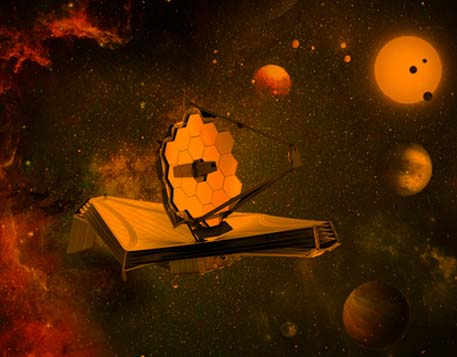
The marvel that James Webb Space Telescope is

Astronomers are keeping their fingers crossed as the James Webb Space Telescope (JWST), recently launched, is speeding towards its parking slot, L2, in deep space. It aims to eye at the early universe, a few hundred million years after the Big Bang. It was an era when the first stars fused the hydrogen atoms into more helium in thermonuclear fusion and radiated the first starlight. The Webb...
Astronomers are keeping their fingers crossed as the James Webb Space Telescope (JWST), recently launched, is speeding towards its parking slot, L2, in deep space. It aims to eye at the early universe, a few hundred million years after the Big Bang. It was an era when the first stars fused the hydrogen atoms into more helium in thermonuclear fusion and radiated the first starlight. The Webb is the successor to the Hubble space telescope. The Hubble was about the size of a school bus, whereas the Webb is about half as big as a jumbo 737 aircraft. With its razor-sharp resolving power (ability to discern fine details), it can show us the first few chapters in the universe’s evolution and perhaps identify exoplanets hosting alien life.
Largest space telescope in history
A galaxy might shine with the brilliance of a billion suns. Nevertheless, the brightness decreases so rapidly that a galaxy at a distance of one billion light-year years will appear as bright as the headlamp of a car 10,000 kilometres away. Now, imagine trying to spot a stellar object at a distance of 10 billion light-years; the challenge gets a hundred times harder. Some 10-15 billion light-years away to look deep into space, we need a telescope that can detect faint stellar objects. The telescope must see things that are 10 billion times fainter than the faintest stars visible to the naked eye, or ten to a hundred times fainter than what the Hubble space telescope can see. As an add on, it is welcome if the telescope could discover Earth-like distant exoplanets or extrasolar planets that orbit other stars.
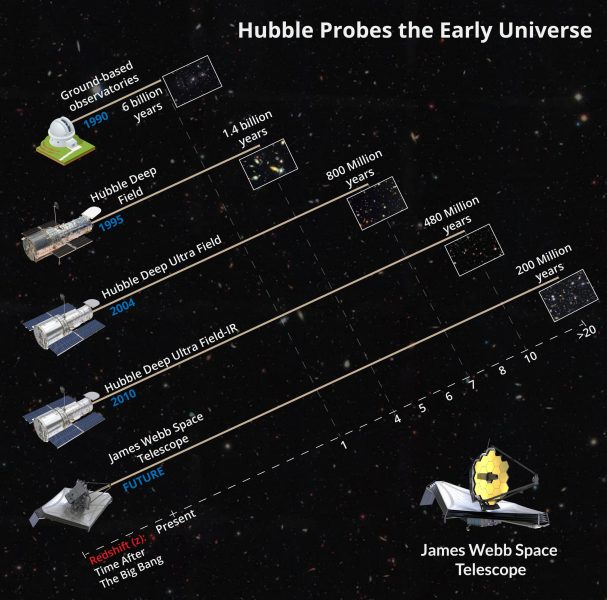
The primary mirror collects the weary photos speeding from afar in a telescope and reflects it to the secondary mirror. As the light rays are focused, we get a sharp image of the distant objects. The larger the primary mirror, the greater the number of photons it can capture. As more photons from a source are captured, even a faint object comes into view. The primary mirror of the JWST, 6.5 metres in diameter, is by far the largest. The Webb space telescope has a light-collecting area that is 6.25 times that of the Hubble. With such a powerful sight, it would see the young infant universe as it was 100-250 million years after the Big Bang when the first-ever stars and galaxies took birth.
The right tool for the right job
The universe we inhabit evolved from the Big Bang that is estimated to have occurred about 13.8 billion years ago. Since then, the universe has been expanding, like the surface of the inflating balloon. Just as the fabric of the balloon stretches as it expands, the fabric of space-time lengthens with the passage of time.
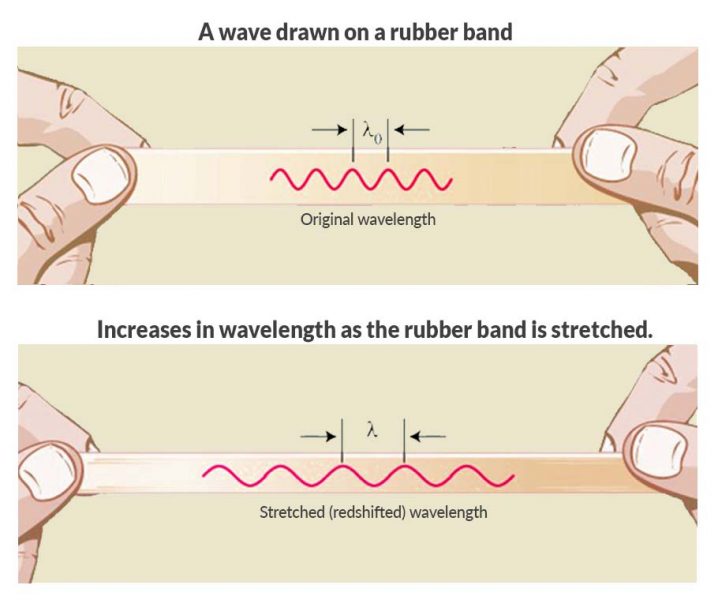
Young massive first-generation stars and galaxies mainly emit ultraviolet and visible light in the blue region. Nonetheless, the light that emanated from the ancient relic of stars had to travel billions of years before it reached us. During this cruise through the expanding space-time fabric, the rays elongate. The stretching is so much that light from the farthest reaches of the universe, travelling for billions of years, often stretches 20 times or more longer. In this process, called cosmological redshift, the ultraviolet and visible light from the early universe becomes infrared radiation when it reaches the telescope.
Thus, optical telescopes are of little use to see the early universe. For the telescope to eye the early stars and galaxies, it must detect infrared rays. This is why the Webb is a large infrared ray space telescope.
Divining the past
A picture is worth more than a thousand words, but a spectrograph is worth thousands of images for astrophysics. A photograph merely shows the existence of an object. However, we desire to know what it is. A spectroscope, an instrument that splits the light into its components and produces a spectrum, acts as the magic wand. The elements which emit the photons create bright ’emission lines’ in the spectra. Gases absorb some wavelengths and create dark absorption lines. By reading these dark and bright spectral lines, we can know many physical properties, including temperature, mass, elemental composition and a wealth of information about the physical conditions in the object.
Astronomers claim that the first stars and galaxies had only hydrogen and helium and tiny amounts of lithium. Further, they say that early stars were massive, 60 times the mass of the Sun. Such massive stars would burn vigorously and last less than one million years. This is why they claim we cannot see any of the early first-generation population-III type stars around us. Cosmologists say that other heavier elements like carbon, oxygen, and iron were formed by the fusion of lighter elements in the cores of these stars.
The Webb space telescope sports several instruments, including powerful cameras and spectrographs. NIRSpec, the Webb’s near-infrared spectrograph, will have the capacity to obtain spectra of 100 objects simultaneously. With the powerful spectroscope attached to the JWST, we can identify the elemental composition of the early stars and galaxies and confirm if the astronomers are right.
Far from the madding heat
The warmth from the boiling water or burning bonfire is actually infrared. So are the rays that come out of the TV remote. Infrared makes the atoms vibrate and is a form of heat. The same heat radiates from the sunny ground, summer sky and our warm bodies. As we cannot see stars in the daytime glare of the Sun, the blaze of infrared radiation from the ambience would swamp and overwhelm the ground-based infrared telescope. Hence, ground-based telescopes cannot help locate faint glow from distant stellar infrared objects. The telescope must be in a super cool place to catch the dim infrared flicker from distant stars, nearly at -230C. Thus, the option of a ground-based telescope is out. This is why the JWST is a space telescope.
The Hubble space telescope orbits 500 kilometres above the Earth. Even in outer space, the infrared radiation from the Sun, the Earth and the Moon would be staggering and play spoilsport unless we head for the point called L2. This particular spot in space, four times the distance of the Moon, about 15 million kilometres away in the opposite direction to the Sun, is called Lagrange point 2, or L2, in short. The gravitational pull of the Sun-Earth system is balanced at this point. Hence, a spacecraft at L2 orbits the Sun tagged along with the Earth in 365 days. Therefore, seen from space, the Sun and the L2 would always appear on both sides of the Earth. Parked at L2, the Webb would avoid the glare of infrared radiation from the Sun, the Earth and the Moon.
How to chill
Any warm object will emit infrared rays. Placing the telescope at L2 helps, but still, the residual heat radiated by the Sun, the Earth and the Moon would be enough to heat the sunward side to +85C. However, the dark side would be chilling –233C. The low-level infrared radiation from the swarm telescope is enough to snuff out the dim glow from the most distant stellar objects in the cosmos. Hence, the telescope must be shielded from the Sun and other heat sources in space. A screen made out of tissue-thin Kapton, a kind of plastic, is used as a sunscreen to keep the radiation from the Sun, the Earth and the Moon in check. Since a thin layer may tear, five layers are stacked to create the shade for redundancy. The screen must be as large as a proper tennis court to shield the entire telescope. The screen would be held in its place with booms, cables and strings, like the sails in a ship.
The JWST is designed to keep the solar panel propulsion system on the sunward side. In contrast, the instruments and the telescope must be huddled on the dark side. Stowed in this super chill state, the JWST would be able to catch even the wisp of heat from the cosmic dawn.
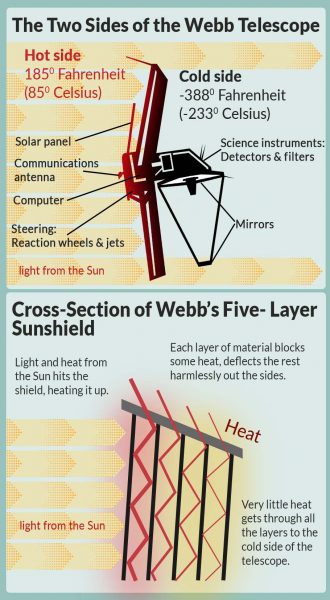
How to put an elephant in a fridge
Getting an elephant into a fridge may be as ‘simple’ as opening the door, putting the elephant inside and closing the door. Building a large telescope was the easy part. How to launch it was a challenge.
A three-story-tall, tennis-court wide telescope will never fit even the best of the Bahubali launch vehicles. The largest payload bay available with the European Ariane 5 rocket is just 5.4-metre-wide and 17 metres high.
The primary mirror is 6.5-metre-wide, and the sun-shield is about 22 metres by 12 metres. The only way these can be tucked into the payload bay is to fold them. The mirrors were segmented into 18 hexagonal shaped segments to enable folding. Made of beryllium and coated with a thin layer of gold, the best material to reflect the infrared rays, these mirror segments unfold into a honeycomb arrangement. The screen was rolled like origami during the launch into zigzags of Z-shaped accordion fold.
Now the craft is speeding towards the L2 at 0.6772 kilometres per second speed and will reach the spot around January 25. During this month-long journey, step by step, various parts of the telescope will be unfolded and put in their place. Immediately reaching space, the solar panel was deployed. Gimbaled Antenna Assembly popped out one day after the launch. Forward sunshield opened on day 3. In its course, the boom arms supporting the sunscreen lower down, five layers of aluminium-coated, heat-resistant Kapton film, each as thin as a human hair, will unroll. Then in the successive stages, booms holding the secondary mirror will extend and lock into place. The telescope will be fully deployed by day 13.
Lastly, just before the final station, the folded honeycomb will unfold. Then using precision motors, called actuates, the mirror segments will be aligned with each other with a precision of 10-nanometre, that is one-ten-thousandth the width of a hair. Once in line, the honeycomb-shaped primary mirror assembly gives a sharp focus – it can see details of an object the size of a 25 paisa coin from 40 kilometres away.
These intricate space waltzes require 50 separate deployments (such as solar panel deployment) and 178 release mechanisms. A delicate dance indeed. Just one misstep, the $10 billion worth Webb space telescope will become the most expensive space junk.
Not a smooth sail
NASA names its space telescopes after American astronomers or just plain acronyms. The Hubble takes its name from Edwin Hubble, Chandra X-ray telescope from Indian-born American astrophysicist Subrahmanyan Chandrasekhar, the Neil Gehrels Swift Observatory after American astrophysicist Neil Gehrels. NASA administrator Sean O’Keefe broke this tradition and suggested naming this telescope after James Webb, a legendary Apollo-era NASA administrator.
Astronomers fumed, and human rights activists pointed out that James Webb was either silent or actively supported and participated in the ‘Lavender Scare’. The government employees with alternate sexual orientations were hounded out. More than 1,200 astronomers signed a petition calling for renaming the telescope. NASA refused, pleading that historians found no wrongdoing on the part of Webb. Nevertheless, the murmurs have not died down.
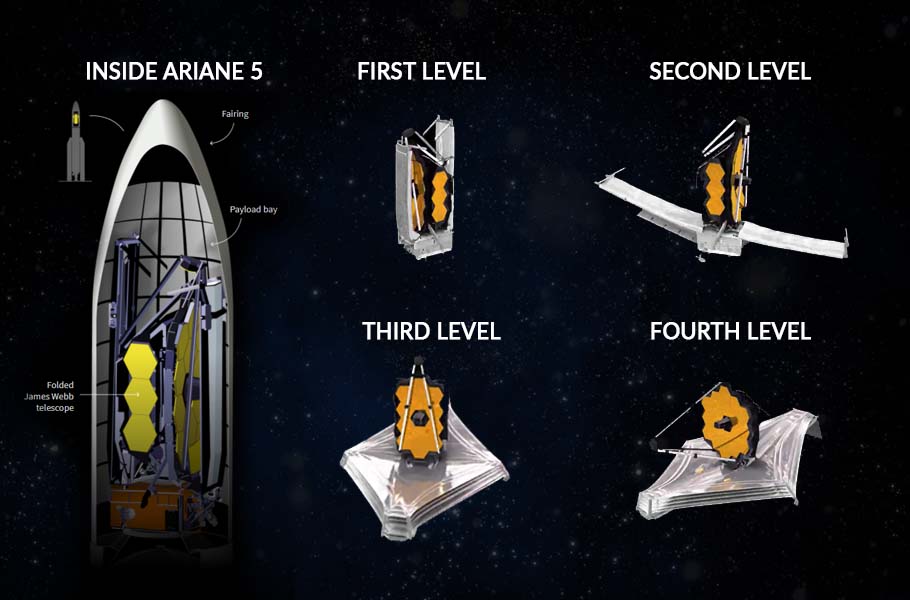
While the name courted confrontation, due to cost escalation, the project itself was about to be dumped in 2011. The spacecraft cost around $10 billion, much less than an aircraft carrier. US lawmakers argued that there was no money for the project. But thanks to the heroic efforts of elementary school students who wrote a letter to US members of Congress and senators, the project was saved in the nick of time.
(This is the first article in a two-part series on the James Webb Space Telescope. Tomorrow read about the cosmic mysteries astronomers hope to solve with the James Webb Space Telescope.)

